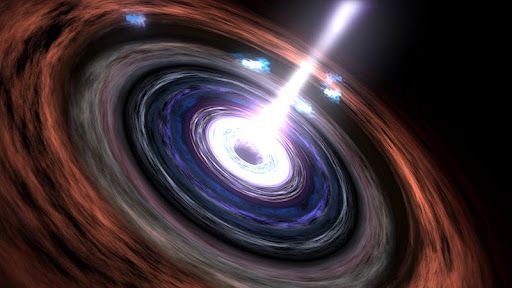More precisely, neutrino particles
Blazars are highly active galactic nuclei containing supermassive black holes that emit streams of matter and radiation aimed directly at Earth.
These blazars can produce and bombard the planet with neutrinos, which are difficult to detect because they have no charge and almost no mass. However, they play an important role in the study of the Universe, as they are able to penetrate barriers that stop other types of particles and even photons. So researchers are racing to identify the sources of neutrinos, and recent research is bringing us closer to understanding that blazars may be one such source.

Blazars are a special type of active galactic nuclei, also known as quasars. They are so bright that they interrupt the light of all the stars in their galaxies. However, blazars differ from ordinary quasars in that their emissions at speeds close to the speed of light are directed directly at Earth.
Supermassive black holes could bombard Earth with ‘ghost particles’
In 2017, the IceCube neutrino observation detector detected a high-energy event coinciding with the flare of the blazar TXS 0506+056. Scientists have localized this source and identified a connection between blazars and neutrinos. TXS 0506+056 is located about 5.7 billion light-years from Earth and is an active galactic nucleus.
However, the real connection between blazar flares and the neutrino stream passing through the Earth still remains a mystery.
To solve this mystery, an international team of researchers conducted a thorough study of TXS 0506+056 and other 144 blazars selected from observational data from the Fermi Large Area Telescope.
Scientists were able to calculate the weekly flux of gamma rays associated with blazars and plot the light curves for these high-energy events. They also developed a “flare cycle” showing the duration of a blazar flare and its contribution to the blazar’s energy.
“We found that among our sample of blazars, the distribution of those with a smaller flare cycle and energy fraction is more numerous. Their cycles represent related patterns. We also found a significant difference between blazar subclasses in flare cycles,” said Kenji Yoshida, a member of the team at the Shibaur Institute of Technology (Tokyo).
The team estimated the neutrino flux from each gamma-ray flare and, by comparing weekly and 10-year predictions for each blazar, set upper limits on the flares’ contribution to the neutrino flux.
The use of such an observational method can significantly contribute to the development of scientific knowledge about the origin of neutrinos.




